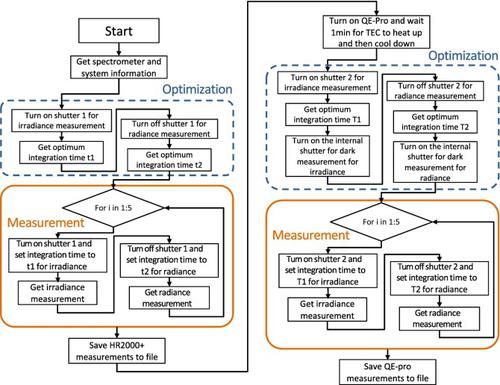当前位置:
X-MOL 学术
›
Remote Sens. Environ.
›
论文详情
Our official English website, www.x-mol.net, welcomes your feedback! (Note: you will need to create a separate account there.)
Immediate and lagged vegetation responses to dry spells revealed by continuous solar-induced chlorophyll fluorescence observations in a tall-grass prairie
Remote Sensing of Environment ( IF 13.5 ) Pub Date : 2024-03-11 , DOI: 10.1016/j.rse.2024.114080 Yao Zhang , Mengyang Cai , Xiangming Xiao , Xi Yang , Mirco Migliavacca , Jeffrey Basara , Sha Zhou , Yuanzhizi Deng
Remote Sensing of Environment ( IF 13.5 ) Pub Date : 2024-03-11 , DOI: 10.1016/j.rse.2024.114080 Yao Zhang , Mengyang Cai , Xiangming Xiao , Xi Yang , Mirco Migliavacca , Jeffrey Basara , Sha Zhou , Yuanzhizi Deng

|
Monitoring plants' responses to water deficit using remote sensing still faces large uncertainty, mostly due to the inaccurate characterization of plants' physiological responses. Solar induced chlorophyll fluorescence (SIF) contains information on plants' physiological processes which regulates the energy partitioning after solar radiation is absorbed by chlorophyll, providing new opportunities to monitor plant response to drought stress. However, the drought-induced physiological, biochemical, and structural changes are strongly coupled, hindering the mechanistic understanding of drought impacts on plants. Here, using tower-based observations of SIF together with high spectral resolution reflectance measurements, we derived the time series of the fraction of absorbed photosynthetically active radiation by canopy, chlorophyll content, and fluorescence efficiency using two radiative transfer model-based decomposition methods, and evaluated their responses to two consecutive dry spells at a tall-grass prairie site in the USA (34°59′05.0″ N, 97°31′20.6″ W). We observed a robust signal of afternoon depression based on the fluorescence efficiency estimates during the second dry spell, which had much lower soil moisture than the first one. The strong decline in fluorescence efficiency in the afternoon was likely caused by the high temperature and atmospheric dryness when the soil was dry. Such a direct physiological response contributed to 14.4% to 36.0% of seasonal variation of afternoon SIF, depending on the decomposition method used. Sustained water stress also caused lagged responses. Despite the subsequent rainfall after the dry spell, we observed a continued decline of SIF due to the lagged decline of chlorophyll content and green canopy coverage. Our study demonstrates the use of continuous SIF measurements to understand the development of drought effects on plants, and highlights the importance of afternoon SIF measurements for physiological stress detection.
中文翻译:

高草草原连续太阳诱导叶绿素荧光观测揭示了植被对干旱期的即时和滞后反应
利用遥感监测植物对缺水的反应仍然面临很大的不确定性,这主要是由于植物生理反应的不准确表征。太阳诱导叶绿素荧光(SIF)包含植物生理过程的信息,调节太阳辐射被叶绿素吸收后的能量分配,为监测植物对干旱胁迫的反应提供了新的机会。然而,干旱引起的生理、生化和结构变化是紧密耦合的,阻碍了对干旱对植物影响的机制的理解。在这里,利用基于塔的 SIF 观测以及高光谱分辨率反射率测量,我们使用两种基于辐射传输模型的分解方法得出了冠层吸收的光合有效辐射部分、叶绿素含量和荧光效率的时间序列,以及在美国的一个高草草原地区(北纬 34°59′05.0”,西经 97°31′20.6”)评估了他们对连续两次干旱的反应。根据第二次干旱期间的荧光效率估计,我们观察到了强烈的下午抑郁信号,该干旱期间的土壤湿度比第一次干旱低得多。下午荧光效率的强烈下降很可能是由于土壤干燥时的高温和大气干燥造成的。这种直接的生理反应导致下午 SIF 季节变化的 14.4% 到 36.0%,具体取决于所使用的分解方法。持续的缺水压力也导致反应滞后。尽管干旱后随后出现降雨,但由于叶绿素含量和绿色冠层覆盖率下降滞后,我们观察到 SIF 持续下降。我们的研究展示了使用连续 SIF 测量来了解干旱对植物影响的发展,并强调了下午 SIF 测量对于生理胁迫检测的重要性。
更新日期:2024-03-11
中文翻译:

高草草原连续太阳诱导叶绿素荧光观测揭示了植被对干旱期的即时和滞后反应
利用遥感监测植物对缺水的反应仍然面临很大的不确定性,这主要是由于植物生理反应的不准确表征。太阳诱导叶绿素荧光(SIF)包含植物生理过程的信息,调节太阳辐射被叶绿素吸收后的能量分配,为监测植物对干旱胁迫的反应提供了新的机会。然而,干旱引起的生理、生化和结构变化是紧密耦合的,阻碍了对干旱对植物影响的机制的理解。在这里,利用基于塔的 SIF 观测以及高光谱分辨率反射率测量,我们使用两种基于辐射传输模型的分解方法得出了冠层吸收的光合有效辐射部分、叶绿素含量和荧光效率的时间序列,以及在美国的一个高草草原地区(北纬 34°59′05.0”,西经 97°31′20.6”)评估了他们对连续两次干旱的反应。根据第二次干旱期间的荧光效率估计,我们观察到了强烈的下午抑郁信号,该干旱期间的土壤湿度比第一次干旱低得多。下午荧光效率的强烈下降很可能是由于土壤干燥时的高温和大气干燥造成的。这种直接的生理反应导致下午 SIF 季节变化的 14.4% 到 36.0%,具体取决于所使用的分解方法。持续的缺水压力也导致反应滞后。尽管干旱后随后出现降雨,但由于叶绿素含量和绿色冠层覆盖率下降滞后,我们观察到 SIF 持续下降。我们的研究展示了使用连续 SIF 测量来了解干旱对植物影响的发展,并强调了下午 SIF 测量对于生理胁迫检测的重要性。



























 京公网安备 11010802027423号
京公网安备 11010802027423号